2017 HONDA CIVIC HATCHBACK child lock
[x] Cancel search: child lockPage 4 of 641

Contents
Child Safety P. 60Exhaust Gas Hazard P. 74Safety Labels P. 75
Opening and Closing the Hatch P. 154 Security System P. 157 Opening and Closing the Windows P. 161
Operating the Switches Around the Steering Wheel P. 165 Adjusting the Mirrors P. 183
Interior Lights/Interior Convenience It ems P. 193 Climate Control System P. 208
Audio Error Messages P. 313General Information on the Audio System P. 317
When Driving P. 422 Braking P. 497Parking Your Vehicle P. 514
Fuel Economy and CO
2 Emissions P. 521 Turbo Engine Vehicle P. 522
Maintenance Under the Hood P. 536 Replacing Light Bulbs P. 548
Checking and Maintaining Tires P. 561 Battery P. 571 Remote Transmitter Care P. 573
Cleaning P. 576 Accessories and Modifications P. 582
Engine Does Not Start P. 593 Jump Starting P. 596 Shift Lever Does Not Move P. 599
Fuses P. 608 Emergency Towing P. 612 When You Cannot Unlock the Fuel Fill Door P. 613
Devices that Emit Radio Waves P. 621 Reporting Safety Defects P. 622
Authorized Manuals P. 627 Customer Service Information P. 628
Quick Reference GuideP. 4
Safe DrivingP. 33
Instrument PanelP. 77
ControlsP. 133
FeaturesP. 217
DrivingP. 415
MaintenanceP. 523
Handling the UnexpectedP. 583
InformationP. 617
IndexP. 630
17 CIVIC 5D (KA KC KL)-31TGG6000.book 3 ページ 2016年6月8日 水曜日 午後2時8分
Page 30 of 641
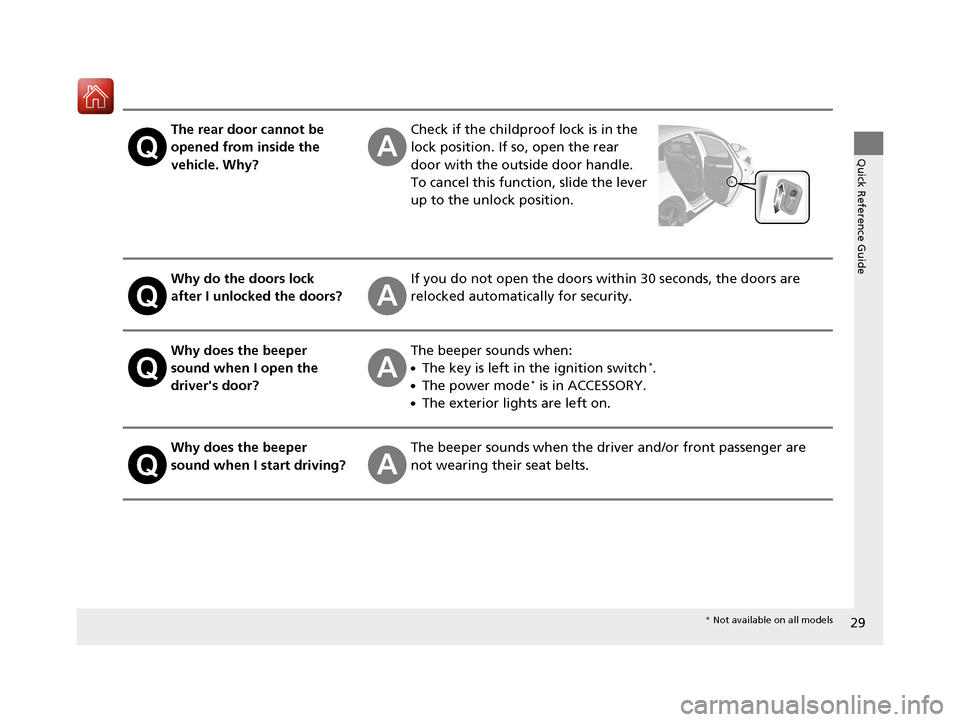
29
Quick Reference Guide
The rear door cannot be
opened from inside the
vehicle. Why?Check if the childproof lock is in the
lock position. If so, open the rear
door with the outside door handle.
To cancel this function, slide the lever
up to the unlock position.
Why do the doors lock
after I unlocked the doors?If you do not open the doors within 30 seconds, the doors are
relocked automatically for security.
Why does the beeper
sound when I open the
driver's door?The beeper sounds when:
●The key is left in the ignition switch*.
●The power mode* is in ACCESSORY.
●The exterior lights are left on.
Why does the beeper
sound when I start driving?The beeper sounds when the driver and/or front passenger are
not wearing their seat belts.
* Not available on all models
17 CIVIC 5D (KA KC KL)-31TGG6000.book 29 ページ 2016年6月8日 水曜日 午後 2時8分
Page 38 of 641
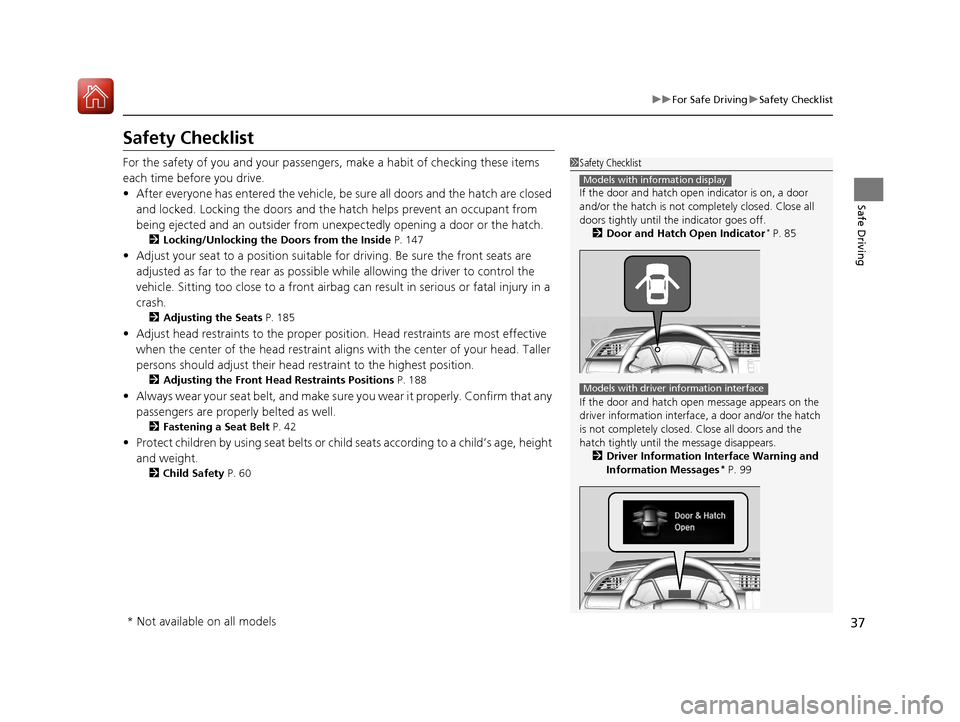
37
uuFor Safe Driving uSafety Checklist
Safe Driving
Safety Checklist
For the safety of you and your passengers, make a habit of checking these items
each time before you drive.
• After everyone has entered the vehicle, be sure all doors and the hatch are closed
and locked. Locking the doors and the hatch helps prevent an occupant from
being ejected and an outsider from unexpectedly opening a door or the hatch.
2 Locking/Unlocking the Doors from the Inside P. 147
•Adjust your seat to a position suitable for driving. Be sure the front seats are
adjusted as far to the rear as possible while allowing the driver to control the
vehicle. Sitting too close to a front airbag can result in serious or fatal injury in a
crash.
2 Adjusting the Seats P. 185
•Adjust head restraints to the proper position. Head restraints are most effective
when the center of the head restraint alig ns with the center of your head. Taller
persons should adjust their head restraint to the highest position.
2Adjusting the Front Head Restraints Positions P. 188
•Always wear your seat belt, and make sure you wear it properly. Confirm that any
passengers are properly belted as well.
2 Fastening a Seat Belt P. 42
•Protect children by using seat belts or chil d seats according to a child’s age, height
and weight.
2 Child Safety P. 60
1Safety Checklist
If the door and hatch open indicator is on, a door
and/or the hatch is not completely closed. Close all
doors tightly until the indicator goes off.
2 Door and Hatch Open Indicator
* P. 85
If the door and hatch open message appears on the
driver information interfac e, a door and/or the hatch
is not completely closed. Close all doors and the
hatch tightly until th e message disappears.
2 Driver Information Interface Warning and
Information Messages
* P. 99
Models with information display
Models with driver information interface
* Not available on all models
17 CIVIC 5D (KA KC KL)-31TGG6000.book 37 ページ 2016年6月8日 水曜日 午後 2時8分
Page 39 of 641
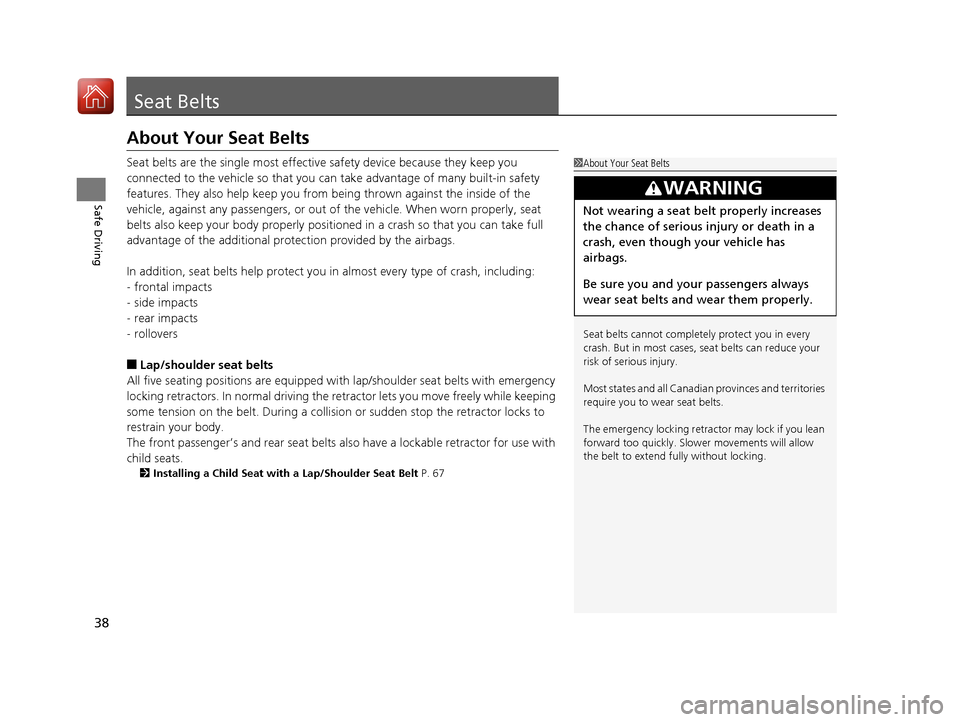
38
Safe Driving
Seat Belts
About Your Seat Belts
Seat belts are the single most effective safety device because they keep you
connected to the vehicle so that you can take advantage of many built-in safety
features. They also help keep you from being thrown against the inside of the
vehicle, against any passenger s, or out of the vehicle. When worn properly, seat
belts also keep your body properly positi oned in a crash so that you can take full
advantage of the additional prot ection provided by the airbags.
In addition, seat belts help protect you in almost every type of crash, including:
- frontal impacts
- side impacts
- rear impacts
- rollovers
■Lap/shoulder seat belts
All five seating positions are equipped with lap/shoulder seat belts with emergency
locking retractors. In normal driving the retractor lets you move freely while keeping
some tension on the belt. During a collis ion or sudden stop the retractor locks to
restrain your body.
The front passenger’s and rear seat belts al so have a lockable retractor for use with
child seats.
2 Installing a Child Seat with a Lap/Shoulder Seat Belt P. 67
1About Your Seat Belts
Seat belts cannot complete ly protect you in every
crash. But in most cases, seat belts can reduce your
risk of serious injury.
Most states and all Canadian provinces and territories
require you to wear seat belts.
The emergency locking retrac tor may lock if you lean
forward too quickly. Slower movements will allow
the belt to extend fu lly without locking.
3WARNING
Not wearing a seat belt properly increases
the chance of serious injury or death in a
crash, even though your vehicle has
airbags.
Be sure you and your passengers always
wear seat belts and wear them properly.
17 CIVIC 5D (KA KC KL)-31TGG6000.book 38 ページ 2016年6月8日 水曜日 午後 2時8分
Page 62 of 641
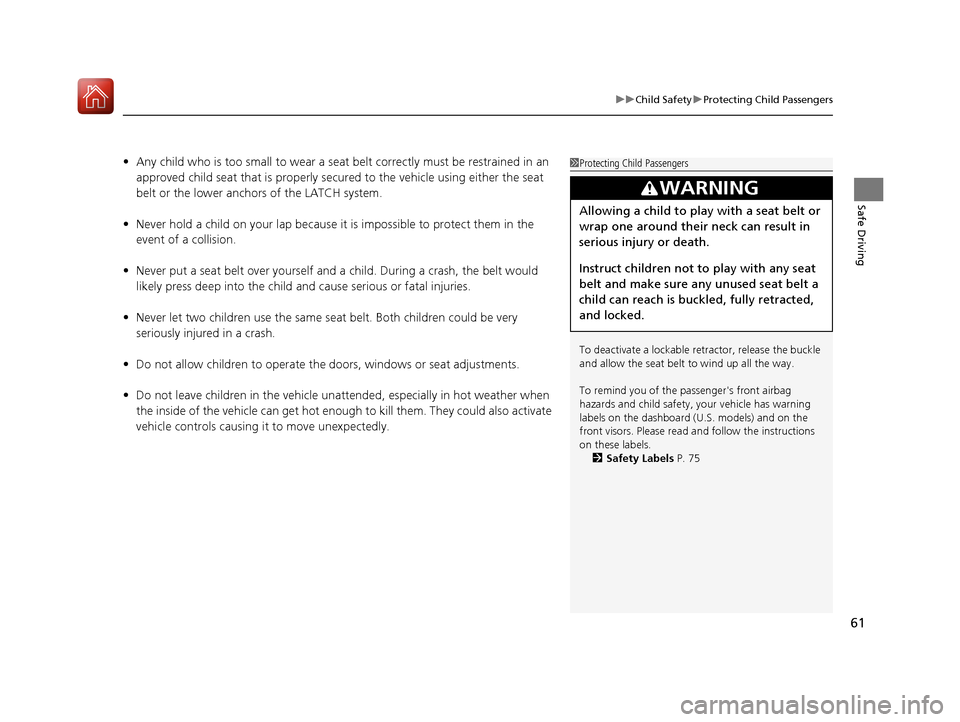
61
uuChild Safety uProtecting Child Passengers
Safe Driving
• Any child who is too small to wear a seat belt correctly must be restrained in an
approved child seat that is properly secured to the vehicle using either the seat
belt or the lower anchors of the LATCH system.
• Never hold a child on your lap because it is impossible to protect them in the
event of a collision.
• Never put a seat belt over yourself and a child. During a crash, the belt would
likely press deep into the child and cause serious or fatal injuries.
• Never let two children use the same seat belt. Both children could be very
seriously injured in a crash.
• Do not allow children to operate the doors, windows or seat adjustments.
• Do not leave children in the vehicle unatte nded, especially in hot weather when
the inside of the vehicle can get hot enough to kill them. They could also activate
vehicle controls causing it to move unexpectedly.1 Protecting Child Passengers
To deactivate a lockable retractor, release the buckle
and allow the seat belt to wind up all the way.
To remind you of the pa ssenger's front airbag
hazards and child safety, your vehicle has warning
labels on the dashboard (U.S. models) and on the
front visors. Please read and follow the instructions
on these labels. 2 Safety Labels P. 75
3WARNING
Allowing a child to play with a seat belt or
wrap one around their neck can result in
serious injury or death.
Instruct children not to play with any seat
belt and make sure any unused seat belt a
child can reach is buckled, fully retracted,
and locked.
17 CIVIC 5D (KA KC KL)-31TGG6000.book 61 ページ 2016年6月8日 水曜日 午後 2時8分
Page 63 of 641
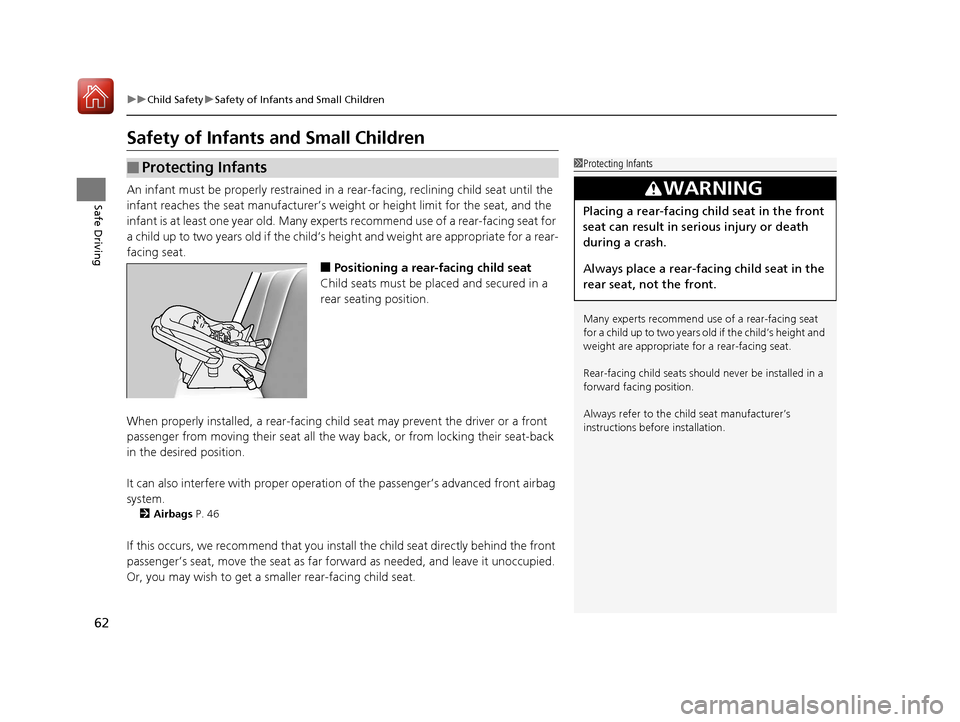
62
uuChild Safety uSafety of Infants and Small Children
Safe Driving
Safety of Infants and Small Children
An infant must be properly restrained in a rear-facing, reclining child seat until the
infant reaches the seat manufacturer’s weig ht or height limit for the seat, and the
infant is at least one year old. Many expe rts recommend use of a rear-facing seat for
a child up to two years old if the child’s he ight and weight are appropriate for a rear-
facing seat.
■Positioning a rear-facing child seat
Child seats must be placed and secured in a
rear seating position.
When properly installed, a rear-facing child seat may prevent the driver or a front
passenger from moving their seat all the way back, or from locking their seat-back
in the desired position.
It can also interfere with pr oper operation of the passenger’s advanced front airbag
system.
2 Airbags P. 46
If this occurs, we recommend that you install the child seat directly behind the front
passenger’s seat, move the seat as far fo rward as needed, and leave it unoccupied.
Or, you may wish to get a sm aller rear-facing child seat.
■Protecting Infants1Protecting Infants
Many experts recommend us e of a rear-facing seat
for a child up to two years old if the child’s height and
weight are appropriate for a rear-facing seat.
Rear-facing child seats should never be installed in a
forward facing position.
Always refer to the child seat manufacturer’s
instructions before installation.
3WARNING
Placing a rear-facing child seat in the front
seat can result in serious injury or death
during a crash.
Always place a rear-fac ing child seat in the
rear seat, not the front.
17 CIVIC 5D (KA KC KL)-31TGG6000.book 62 ページ 2016年6月8日 水曜日 午後 2時8分
Page 67 of 641
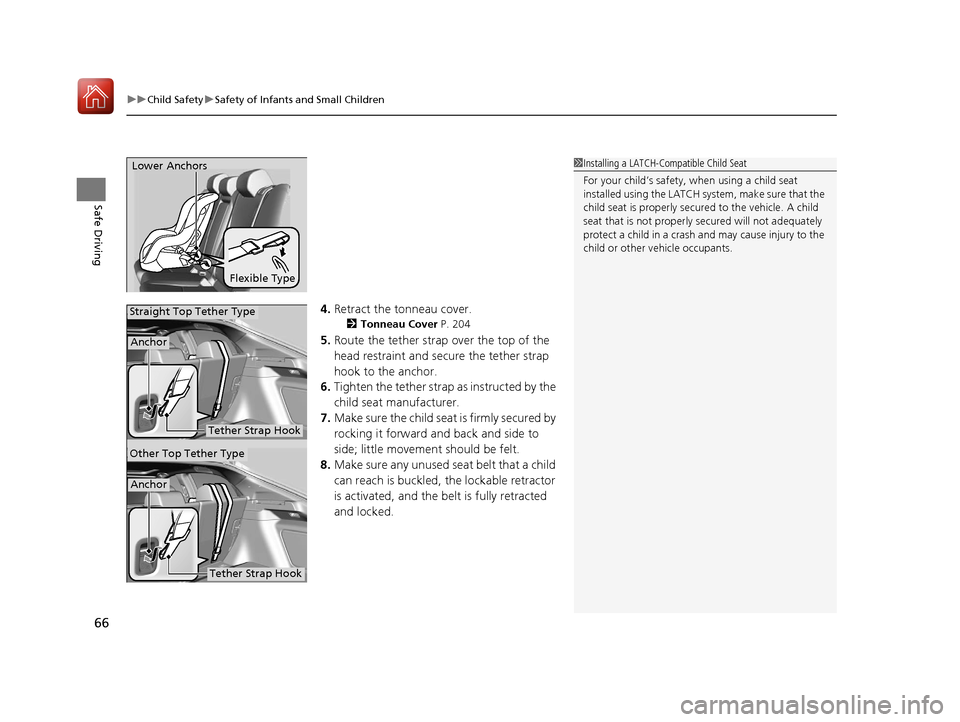
uuChild Safety uSafety of Infants and Small Children
66
Safe Driving
4. Retract the tonneau cover.
2 Tonneau Cover P. 204
5.Route the tether strap over the top of the
head restraint and secure the tether strap
hook to the anchor.
6. Tighten the tether strap as instructed by the
child seat manufacturer.
7. Make sure the child seat is firmly secured by
rocking it forward and back and side to
side; little movement should be felt.
8. Make sure any unused seat belt that a child
can reach is buckled, the lockable retractor
is activated, and the be lt is fully retracted
and locked.
Flexible Type
Lower Anchors
1
Installing a LATCH-Compatible Child Seat
For your child’s safety, when using a child seat
installed using the LATCH system, make sure that the
child seat is properly secured to the vehicle. A child
seat that is not properly secured will not adequately
protect a child in a crash and may cause injury to the
child or other vehicle occupants.
Anchor
Straight Top Tether Type
Other Top Tether Type
Tether Strap Hook
Tether Strap Hook
Anchor
17 CIVIC 5D (KA KC KL)-31TGG6000.book 66 ページ 2016年6月8日 水曜日 午後 2時8分
Page 68 of 641

Continued67
uuChild Safety uSafety of Infants and Small Children
Safe Driving1. Place the child seat on the vehicle seat.
2. Route the seat belt through the child seat
according to the seat manufacturer’s
instructions, and insert the latch plate into
the buckle.
u Insert the latch plate fully until it clicks.
3. Slowly pull the shoulder part of the belt all
the way out until it stops. This activates the
lockable retractor.
4. Let the seat belt retract a few inches and
check that the retractor has switched
modes by pulling on the webbing. It should
not pull out again until it is reset by
removing the latch pl ate from the buckle.
u If you are able to pull the shoulder belt
out, the lockable retractor is not
activated. Slowly pull the seat belt all the
way out, and repeat steps 3 – 4.
■Installing a Child Seat with a Lap/Shoulder Seat Belt1 Installing a Child Seat with a Lap/Shoulder Seat Belt
A child seat that is not properly secured will not
adequately protect a child in a crash and may cause
injury to the child or other vehicle occupants.
17 CIVIC 5D (KA KC KL)-31TGG6000.book 67 ページ 2016年6月8日 水曜日 午後 2時8分